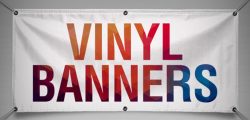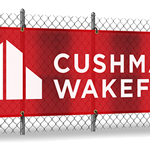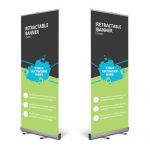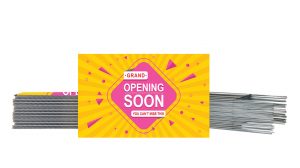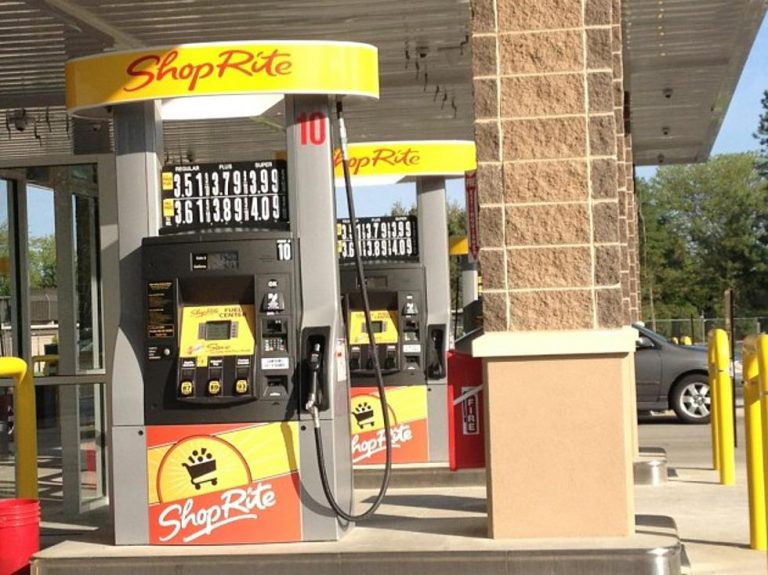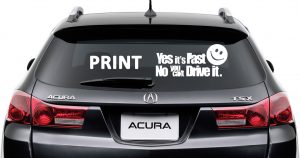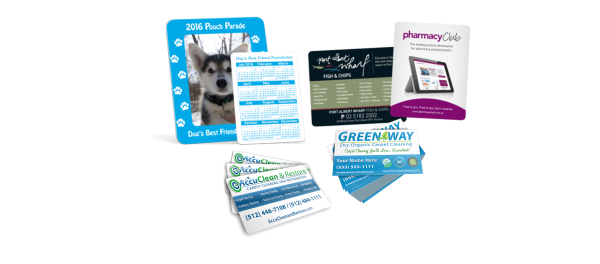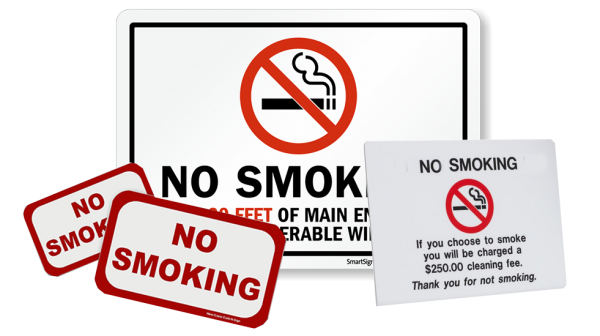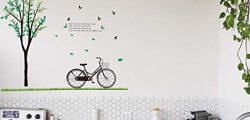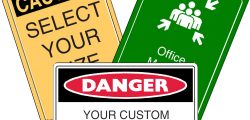Usage
Can I reuse it?
Your vinyl lettering can be removed at any point without any trouble. Though the vinyl lettering is a semi-permanent use and not repositionable. Once you have firmly applied the lettering, you will not be able to move it and then reapply it.
What surfaces can I apply it to? Any restrictions?
Generally speaking the principle of vinyl lettering usage is that it will work on a smooth, non-porous surface. Thus metal, glass, plastic, painted drywall, tile, painted wood, and more are great places to put your lettering. It will not work on porous surfaces, even if such a surface is including in the previous sentence. For example, untreated and rough wood will not work while a painted or treated wood most likely will. Specific places where it will not work include brick, cinderblock, heavily textured surfaces, stucco, unfinished wood, concrete, some types of wallpaper, paneling, etc.
What about cars, trucks, boats, etc? Can I install here without ruining my paint?
Yes, our lettering works on the interior or exterior of all types of vehicles. This includes both cars and trucks as well as boats. Using vinyl lettering on a car, truck or boat should not damage the paint job of the vehicle or boat as long as removal is done carefully and correctly.
Will my lettering work on tinted windows?
Yes, vinyl lettering will work on tinted windows. The caveat is that the sign and lettering needs to be designed with this in mind. A light color or white should be used to provide the needed contrast to ensure maximum visibility of the sign. Dark colors on a dark or tinted window will not be very visible, if at all. Also, all installation on tinted glass should always be done on the side of the window where you want the lettering visible to the customer. Don’t attempt to install in a way that you look through the tinted glass to see the lettering.
Can the lettering be used outside?
Yes, our vinyl lettering can be used for both indoor and outdoor application. Climate, installation and care and maintenance will impact the lifespan of the lettering but they should last 8-10 years.
Will the lettering ruin my painted wall? What about wallpaper?
Vinyl letters should not ruin your paint regardless of how long they are in place. The only damage that may occur is using a sharp edge when trying to peel them away and chipping or peeling the paint away. Nonetheless, with or without a sharp edge, we recommend that removal is done with the utmost care to ensure no damage to any underlying paint.
Not all wallpaper is created equal. Our vinyl lettering will work on some surfaces with wallpaper and others it won’t. If your wallpapered wall is smooth and non-porous and you still have concerns please contact us about a sample. We offer free samples if the shipping is paid for. Textured wallpaper will not work with the lettering. Assuming the lettering works, removing the lettering should not damage the wallpaper itself excepting damage done when using a sharp edge for removal.
Can I apply it on wet or new paint?
Vinyl lettering should not be applied to any surface that has been very recently painted. Painted surfaces should be allowed 2-3 weeks to dry and cure properly before applying the lettering. Doing so sooner risks damage to the paint.
Are there restrictions on types of paint I can apply it to?
Your vinyl letters will work best on semi-gloss and glossy paints. Generally speaking latex and oil based paints will work. This covers the majority of homes and businesses. Alternatively, faux, flat, satin, magnetic suede and sand paints will not work well with the vinyl’s adhesive.
How do I remove the lettering? What if it has been applied for a long period of time?
The majority of lettering can simply be peeled away like any other sticker. We recommend peeling it away slowly to ensure no damage to any paint. Residual adhesive, if any, can be removed with a very mild cleaner and water and light scrubbing. In some cases a sharp edge may be needed to remove lettering that has been in place for extended periods of time. Be careful not to damage the application surface when using these tools.
What are the typical uses of vinyl lettering?
Typical uses of vinyl lettering are largely broken down into two main uses. These areas of use are business and home related. For businesses, storefronts advertising store hours, sales and promotions are common. Likewise, internal offices can feature decor, motivational quotes, room numbering and much more. Likewise, fleet cars can feature a variety of lettering including registration numbers, contact information, website and business names.
Home or residential uses can be for home decor (quotes, house rules, chores, welcome, etc.) as well as no soliciting, security warnings, and more.
What is the level of opacity of the lettering?
The vinyl lettering is opaque, but thin enough that some light will pass through when installed on windows. The darker the color, the more opaque it tends to be.
Can I place the lettering on the inside of the window and have it be visible from outside?
Yes, lettering can be created to be visible from outside with internal placement. This is called “Reverse Cut” and should be selected as an option when ordering your lettering.
Can the lettering be used in humid locations?
Generally speaking your lettering will work just fine in humid locations or rooms (bathroom) and climates. The only exception to this is a surface(s) that is wet when applied as the adhesive won’t properly adhere when initially installed. Extremely humid locations may reduce the lifespan of the decal but the lettering should still last years with proper installation and care.
Can I store my lettering for future use?
Your lettering can be stored for a short period (no greater than 1-2 months) but should be installed as soon as possible to ensure that the adhesive works correctly when applied.
Installation & Care
Is the lettering easy to install?
Vinyl lettering installation does not require professionals or a paid service. Though large quotes or stickers may require more than one person to prevent the lettering from prematurely sticking to the surface or to itself.
*Designs with three or more colors will require you to place the vinyl lettering in layers on your wall. This process will be outlined below.
The steps to install your lettering are below. Please read all the steps before starting the installation. The steps outlined below should be followed in order to ensure proper installation.
1. Clean the surface where the lettering will be installed with a non-abrasive rag and very mild cleaner or slightly soapy water.
2. Allow the surface to completely air dry before beginning installation.
3. Measure the area where the lettering will be installed.
4. Mark in a non-permanent fashion where you want the lettering to be applied. Ensure it is level and will be correctly placed after installation.
5. Without removing the backing of the lettering or the transfer tape (on top of the lettering) use masking or painter’s tape (or other suitable tape) to affix the top edge of your pre-masked vinyl lettering to your previously marked location.
*For designs with three or more colors: two vinyl lettering dots (one in the upper left and one in the bottom right) will be included with your design on each layer to assist in correctly lining up each layer on your wall.
6. Carefully peel away the backing of the decal from the top of your lettering that is affixed to the wall. Do not peel away all of the backing. Only peel away a thin horizontal stretch of the backing initially. Do not let the lettering or transfer paper (both of which now have the adhesive side exposed) touch the wall.
7. While still holding both the adhesive sides and backing away from the wall, use your hand or a flat surface (like a credit card or squeegee) to evenly and firmly press the adhesive backing of the letters and transfer paper to the surface. Move from top to bottom across the horizontal stretch you exposed in the previous step.
8. Continue to peel away the backing little by little while evenly and firmly press the lettering (with the transfer paper on top of it) onto the surface.
9. Once the lettering is fully adhered to the surface, carefully remove the masking tape hinge and transfer tape.
*For designs with three or more colors: once the first layer is applied to your wall (including the dots in the upper left and bottom right corners), place the next layer by aligning the dots of layer 2 with that of layer 1 (note: the layers are not labeled). Continue application of the layers using the dots on the wall by repeating the same steps above.
10. Your vinyl lettering is now installed on the surface where you want it.
11. Remove any bubbles that remain. Remove any non-permanent markings that may remain.
*For designs with three or more colors: remove the vinyl dots leftover from the installation process. Carefully peel them away from the wall by using your fingernail or a sharp edge. Take care not to scratch away paint or damage the your vinyl lettering design.
Additional Helpful Tips & Hints
Larger lettering signs can be installed piece by piece by cutting the order between words. Make sure that the backing and transfer paper are not removed and simply cut in between the words after affixing it to the surface with masking tape. This will allow you to repeat steps 6-8 by doing smaller portions of the entire phrase or quote while still keeping aligned and situated correctly as per your markings. For very large stickers this can be done not only between words but as often as possible, even for every letter, if needed.
Alternatively, a middle rather than top hinge (i.e. with the masking or other suitable tape) can be used. A middle hinge just means that the tape you use will run vertical rather than horizontal. This is effective for longer quotes and words that are wider than they are tall.
What do I need to install it?
The only essential item beyond a measuring tape we’d recommend is masking tape. This will allow you to affix the lettering in the proper location and install the decal exactly where you want it.
If available, a flat surface tool, such as a squeegee, would be an added bonus. Though using your hand, a credit card, or even a hardcover book works just fine in almost all cases. Additionally, a level may help to ensure your lettering is installed evenly rather than crooked due to a failed eyeball test. Lastly, if the surface is extremely dirty then we’d recommend using a spray bottle and rag, or just a damp rag, to clean the surface before installing the lettering.
Do you provide any tools for application?
Currently we sell only the squeegee for a very small cost to aid in installation. Most hardware and office supply stores will have whatever else you might need.
Do installation instructions come with my order?
Installation instructions are included on the pack slip that comes with your lettering. It also contains a link to this page for more detailed instructions and additional resources.
What happens if there are bubbles when I apply it?
If applied correctly there should be no bubbles after installing your lettering. Small bubbles that appear can be remedied by carefully lifting the portion that was just applied. Large bubbles that risk tearing the lettering or rendering it inoperable can be punctured with a pin or needle. Air can then be removed by carefully using your hand or a flat surface against the surface. Extreme care should be used to avoid wrinkles when attempting to eliminate large bubbles.
Is there any ongoing maintenance needed for the lettering?
Assuming it was installed properly the only ongoing maintenance is a light cleaning of the lettering. This can be done with a damp, non-abrasive cloth to help prevent dirt or grime buildup on the lettering. Do not scrub vigorously when cleaning the lettering and avoid peeling up any corners. A curled or damaged corner can lead to lettering that eventually falls off the surface where applied. Do not use strong cleaners that can potentially damage the adhesive properties of the lettering.
Should I clean my lettering that is used outside?
Yes, whether used inside or outside your lettering should be regularly cleaned with a non-abrasive damp cloth. Do not use strong cleaners or scrub too hard in order to avoid damaging the lettering.

